they are at a good working height
they are more water-efficient than in ground beds or standard raised beds
they provide consistent soil moisture over summer which many of our food plants appreciate
even at the height of a hot summer their reservoirs may need to be filled only once every fortnight
They do take a bit of work to set up, but once they're done they're done. A few things to consider:
1. Dimensions:
- not too wide: you need to be able to reach to the middle (1.2m max
- 300-400mm soil depth
- 150-200mm reservoir depth
2. Reservoir fill: We like 20mm scoria. Others use gravel, sand, 10mm scoria, or wood chips.
3. Liner:
A double layer of builders' plastic is cheap and will work (protect it from any sharp points with layers of old
carpet/shade cloth/weedmat/geotextile below and any of the latter three laid on top).
Otherwise source pond liner which is more robust, but still play safe and protect it from sharp points.
A leak once the bed is completed would be very disappointing.
4. Soil:
Recommended by a professional:
40% potting mix for friability; 40% compost; 10% sandy loam; 10% clay loam.
Ordinary garden soil is not recommended.
Add a layer of straw mulch to prevent moisture evaporating in hot weather.
5. Maintenance:
Because of the large amount of organic material in the soil mix, the level in the bed will subside.
Top up between crops with more compost, rotted manure, straw etc.
Careful with the application of fertilisers.
A wicking bed is something of a closed system, and you can get a build up of fertiliser that won't help the
plants.
Find more information online - there is plenty. Read up thoroughly, then start work!
Here's how we did it:
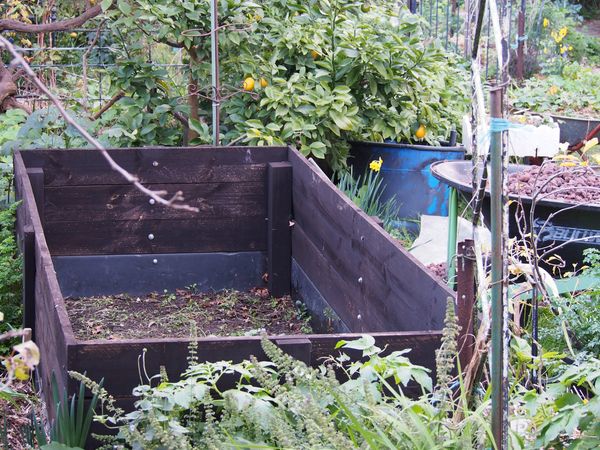
A raised 2.4m
x 1.2m garden bed has been extended
in height with three rounds of ecowood plinth (non-
arsenic treated pine).
100mm x 100mm posts
reinforce the corners, and on
the outside treated pine bracing has
been added.
The timber has been coated with food-safe bitumen
paint for durability.
On the bottom, old carpet protects the waterproof
lining.
On
top of that, a layer of weed mat extends up
the sides. Then the plastic - a double layer of
builders' plastic.
Over the
plastic, on the base is some old shade
cloth, then another layer of weed mat extending up
the sides (We really don't want punctures in the
plastic!).
Water inlet:
A piece of second-hand down pipe makes a water
inlet. It is attached to a pieces of 50mm slotted agi
pipe which snakes across the base of the bed and
is now covered by a 15cm layer of scoria. This
pipe ensures that water flows quickly through
reservoir.
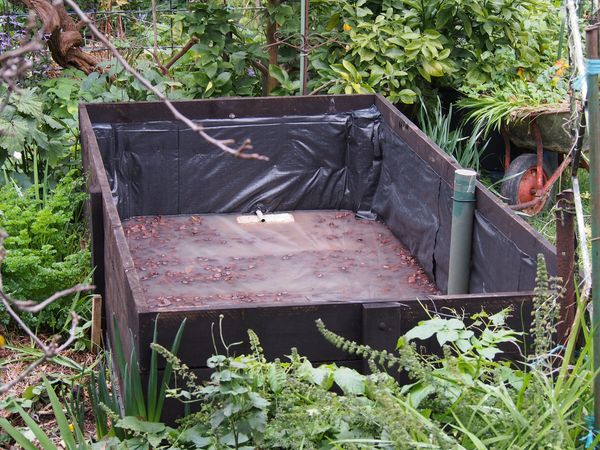
A piece of used conduit becomes the overflow
pipe, sited level with the top of the scoria. The
inside end of the pipe is covered with a piece of
weed mat to stop soil blocking it.
Sealing the plastic liner around the overflow pipe is
the trickiest bit - again we don't want leaks.
We used aquarium-safe silicon and cable ties.
(Next time we will use
a tank outlet.)
Water has been added so as to check that the
scoria is level.
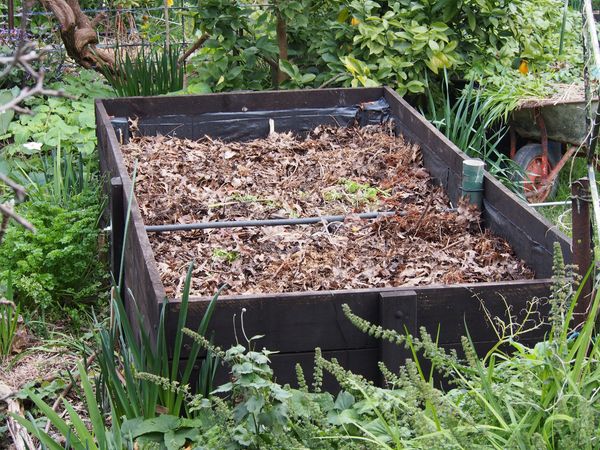
A layer of geotextile has been laid over the scoria
to separate the reservoir from the soil.
And
finally - the soil.
Mostly compost, some prunings, second-hand
potting mix from a local nursery, chunky coir, and
the soil from the original raised bed. And autumn
leaves.
A steel rod has been
added to brace the sides.
All ready to plant out!
Six tomato plants are growing
strongly.
Over the summer season these plants grew
enormously and fruited prolifically.
Some plants thrive on the consistent moisture
provided by wicking beds,
These include tomatoes, basil, coriander, celery
and lettuces.
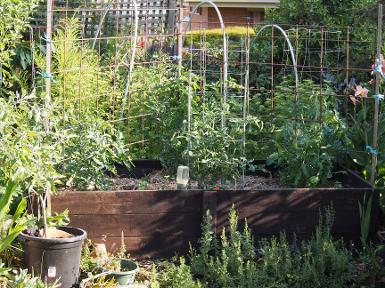
Wicking Beds and Climbing Frames
Growing vegetables vertically on frames or stakes is often necessary because of the growth habit
of the plant.
It also economises on space. More pods are harvested from climbing beans and peas than from dwarf
varieties in my experience, and cucumbers climbing over a frame rather than sprawling across the
garden bed free up garden space.
Tomatoes and cucumbers are less prone to fungal disease and the illicit munching of snails and slugs
if grown up frames (or stakes in the case of tomatoes).
Wicking beds, however, need some creativity when it comes to stakes and frames.
You can't hammer stakes or frame supports far enough into a wicking bed for stability.
There are, however, solutions. Here are a few.
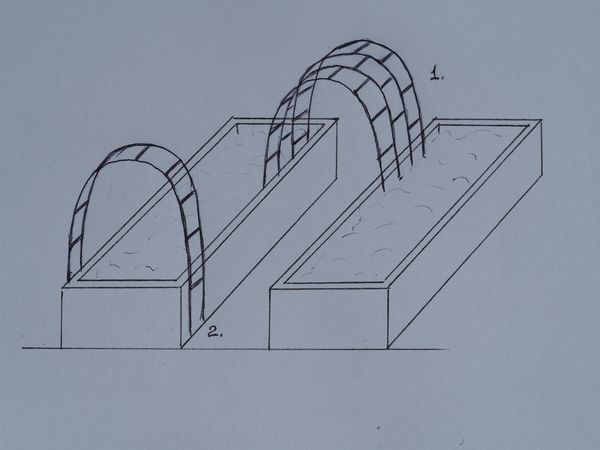
Cheap garden arches work well for tomatoes and
beans. The arches can straddle two adjacent
wicking beds with saddle brackets attaching them
to the inside of the beds.
The arches can be made shorter by not using the
bottom pieces of tubing. Those bits can be used
instead to join two garden arches together making
an archway about 1.2 metres
wide.
Arches can also be attached to the outside of a
wicking bed – again using saddle brackets. It is
probably best to position the arch near the end of
the bed or reaching the fruit might be a challenge.
It is easy to have sets of brackets in different
positions along the side of a timber-framed wicking
bed so the arches can be moved to different spots
for crop rotations.
We
bend expanded aluminium screen doors (outer
frame removed) to use as cucumber frames. One
edge sits in the garden bed and the other outside,
making a low arched frame that keeps the plants
off the ground. This technique could be used with
wicking beds too.
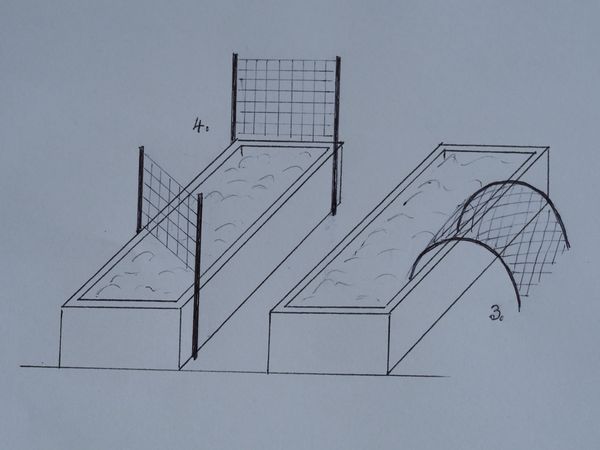
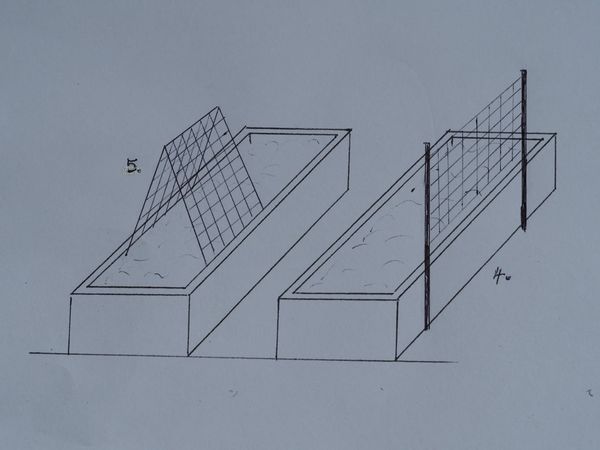
Supporting stakes or posts for reo (a.k.a.
weldmesh) or other types of mesh can be
positioned outside the wicking bed.
For lighter structures bamboo poles or tomato
stakes can be attached to the sides of the wicking
bed with brackets.
For sturdier frames hammer garden stakes into the
ground, or make it more permanent by digging and
cementing poles into place.
The reo tent (5.)
This
simple frame worked well for rampant Mini
Roma tomatoes..
Two pieces of heavy duty reo were
positioned on
opposite sides of the wicking bed and tilted
inwards so their top edges leaned on each other to
make a tent shape. We used reo off cuts about
90cm wide and 1m-1.2m long. The tomato stems
were
trained around or tied to the reo as they grew.